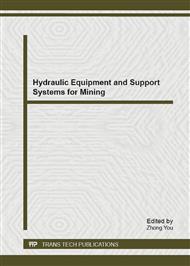p.249
p.253
p.259
p.264
p.270
p.275
p.282
p.286
p.290
Study of a New High Frequency Moving Coil Linear Force Motor for Electro Hydraulic Servo Valve
Abstract:
There are some problems in moving coil linear motor for Electro-hydraulic servo valve, such as big weight, small electromagnetic force, long response time and small bandwidth. After simulation analysis on permanent magnet placement and permanent magnet magnetization direction, it is found that distribution of magnetic field lines is uneven, magnetic flux density is low, and magnetic field lines are not vertical with the coil current direction. To solve these problems, a new type of linear force motor with 5 rings stack Halbach permanent magnet array structure is put forward. Through using the new structure, the weight and volume of motor can be reduced, and the electromagnetic force can be increased. Simulation results show that for the new structure, under the coil displacement change, the output electromagnetic force changes little and can maintain good linearity. Using permanent magnet with same volume, the electromagnetic force produced by new force motor is 2.5 times as it is produced by current motor. If the electromagnetic forces produced by two structures are same, the step response time of new type can be decreased of 14.3%, and the bandwidth can be improved to 2 times.
Info:
Periodical:
Pages:
270-274
Citation:
Online since:
December 2012
Authors:
Keywords:
Price:
Сopyright:
© 2013 Trans Tech Publications Ltd. All Rights Reserved
Share:
Citation:


